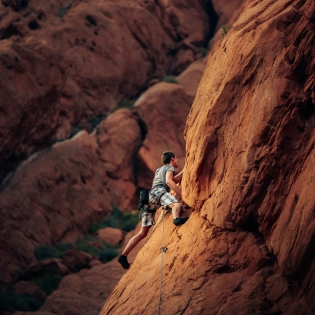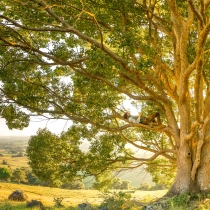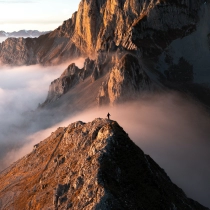While you technically can climb in regular sport shoes, and even with no shoes, it is highly recommended to climb in climbing shoes to not only help you climb better, but also to prevent injuries. In some climbing gyms, it is a requirement to climb in climbing shoes.
Climbing holds are very rough and can damage your normal sport shoes if you climb in them often. Climbing shoes on the other hand are made specifically for these rough surfaces. They are made to handle gritty rocks and climbing holds and to not get ruined by them.
Climbing shoes will also help you climb better and give you a much better experience overall, as long as you choose the correct size for your climbing shoes.
Most climbing gyms have rental climbing shoes that you can use so that you can get used to the type of shoe before spending a lot of money on new ones.
Generally, you would not wear socks with climbing shoes unless you have a reason for it. Socks can help prevent chafing by providing an extra layer between your toes and the shoes. This could help in cases where you have new climbing shoes that are very tight or that you are not used to yet, or, you are a beginner climber, and you are not used to your climbing shoes yet. In these cases, the climbing shoes may be rubbing against your toes to the point where it actually breaks the skin and peels a thin layer off. Wearing socks can prevent this.
Other than this, though, it is usually preferred to not wear socks, since an important reason for climbing shoes being so tight is so that your foot will not slip inside of it or move around. Wearing socks can cause your foot to move around in your shoe, even in very tight climbing shoes. This can happen especially in the heel area and when you have difficult heel hooks where you really have to pull on your heel. Wearing socks can cause your shoes to not stay on as tight as they should, and could result in your foot slipping, the heel of the shoe coming off, and even in injuries if your foot slips in a risky way.
So the recommended way to wear climbing shoes is without socks. If you really want to, though, you can find a thin pair of socks to wear, just until your toes get used to the friction of the climbing shoes.
Climbing shoes are bent downwards to enable you to put more weight on very small edges. By being bent downwards, you are able to apply more force on the small edge without the shoe slipping off.
Bent climbing shoes are normally better for bouldering and overhanging routes, as they allow you to have a better grip on the holds, which enables you to pull harder on your toes and keeping your body close to the wall. All of this allows you to reserve more energy in your arms.
Though they are mostly used for bouldering and overhanging routes, they are not limited to them. There are many climbers who prefer aggressive downturned climbing shoes over neutral ones for sport climbing also.
Another element of aggressive climbing shoes is a slight twist in the direction of the big toe. This allows you to put even more force and power onto the toes, allowing you to have an even better stance on those very small edges.
I remember when I bought my second pair of climbing shoes, the ones I bought to replace my beginner shoes I wore for 6 months. I ordered them online and bought a size and a half (at least!) too small.
They were extremely painful to wear, even to just stand in.
My friend, with many years of experience, kept saying it's fine and that I should just wear them and climb in them, and they will loosen up.
I did as he said, but this didn't really work. They did loosen up a little bit even after climbing in them for just a few minutes, they did feel slightly better, but they were still horribly painful to wear.
The reason is, they were just too small! Climbing shoes should not be too small to begin with, even if you are expecting them to stretch and loosen up.
Also, they were synthetic. Synthetic shoes do not stretch as much as leather shoes stretch, so even if they would have stretched eventually by using them and climbing in them, they would not stretch enough to actually make them not hurt, they were at least 1.5 sizes too small to begin with.
And those are the two main points that I have used since then when buying shoes and making them not hurt:
1. Understand what you are buying
If they are leather, they will probably stretch a lot after using them for a while, so if you buy a smaller shoe size, it will probably be uncomfortable in the beginning, or even slightly painful, but as you use them, they should loosen up to be a great fit, just as long as you don't go down in size too much, they shouldn't actually be really painful.
If they are synthetic, keep in mind that they will probably not stretch too much, and if you buy size 10, they will probably stretch at the most to 10.5. I have bought since then 4 pairs of shoes, all synthetic, and none of them have noticeably stretched. They are still as tight as I bought them.
So keep this in mind when buying shoes, since if you buy synthetic shoes that are a few sizes smaller while thinking that they will stretch after you use them and that they will be a good fit, you may be quite disappointed.
2. Wear them!
My friend was actually right, wearing the climbing shoes does stretch them, even for that session, making them much more bearable throughout the session compared to when you are just putting them on.
Of course, if you downsize synthetic shoes too much, like in my accidental case, wearing them probably won't help much. But if the shoes are properly sized to begin with, then you should be fine with just wearing them and climbing with them, they should stretch and loosen up.
Rock climbers are very efficient at pacing themselves, and only exerting the required amount of energy, and no more. They achieve this through training, experience, and properly reading the route.
Climbers do in fact get tired, just after a different amount of time than others, and they are able to handle it better than others.
In order for a climber to complete a route, which can sometimes very long and physically demanding, they must first understand the route and it's requirements, and what options they have that can help them finish it. Based on that, and on an understanding of what their own strengths are, they will decide on the beta that suits them best.
Knowing what they need to do on the route and properly reading it and coming up with the correct beta for themselves also allows them to find good resting spots. These resting spots are crucial for long and tough routes, as the climber can spend enough time in these resting spots to recover and to reduce the pump in their arms.
Climbers also train very hard in order to reduce the effects of the pump they feel in their arms, so that they are able to climb through it better, and to delay the pump from ever happening.
Here are 6 exercises and tips that I use that have helped me climb better and get better at bouldering:
1. Slow and Quiet Climbing
This is probably one of my favorite exercises, and one I do every time I go climbing as a warm-up, and as I finish climbing.
What you do is you simply climb easier routes, but quietly. If you make any sound at all (not including clicking sounds from fingers or legs, or sounds from the shoes such as the rubber or the Velcro), you get off the route, and start the route over again.
What this does is it teaches you to be more precise with your movements and hand and foot placements, as you have to really grab the hold slowly and softly to not make a sound.
It strengthens your muscles because as you climb slowly, you will find yourself in more lock-off positions, where you are holding your body weight with more of your muscles.
It's a great warm-up when doing it on easier routes, and is great for some extra low intensity climbing at the end of the session, but, it's also a great exercise to keep in mind while climbing difficult routes also, as the precision in the movements and limb placements can really make a huge difference in the harder routes.
It's a great exercise to really give your technique a boost.
2. Moonboarding or other tension boards
Strength may not necessarily be more important than technique, but it is important. Grip strength, finger strength, and pinch strength are crucial for climbing harder routes, especially for overhanging routes.
Grip and pinch strength can be trained in isolation with punch blocks and other gear, but one of the best ways I have found to increase my strength, and not just in my hands, is the moon board. It is also much more interesting than just lifting a block of wood for a few seconds as you are actually climbing. It also strengthens your core, shoulders, back, and other muscles in addition to just grip strength.
If you have a moonboard or any kind of tension board, I highly recommend dedicating a session or two per week to climbing only on it. After even just a month, you should be able to see the difference in your strength.
3. Projecting
Many climbers choose to only climb routes that are around their climbing level. This could be out of comfort, or out of the idea that they just can't climb harder routes because they are not there yet.
Climbing routes that are above your climbing grade can actually be one of the best things you can do for your climbing.
First of all, you may actually be surprised and may be able to climb the harder routes.
If not, even if you work on the route and get just a few movements in, those movements can go a long way in improving your overall climbing abilities, knowledge, and experience.
Plus, when you actually finish the route, the amount of motivation you will feel will be unmatched, a perfect dose for climbing harder and choosing another project.
4. Strength training
As mentioned, strength training is very important. Not just finger strength, but general body strength. This includes the back, shoulders, arms, chest, core, and legs.
Also, training antagonist muscles is very important as it can help prevent injuries due to imbalances and poor posture.
I would add a few weight lifting or body weight training days to your climbing schedule, to make sure that you are giving your whole body a proper workout.
5. Feet work
Most beginner climbers don't understand the importance of feet work. They think it's just an upper body sport, mainly for the back and arms.
This is very far from the truth, as feet work can be the defining element between success and failure on a route. You can be as powerful and as strong as you want, but if you have poor footwork, everything will just be that much harder for you.
Climbers who are not very strong often times climb better than those who are because they have much better technique and foot work. They cannot rely on their strength since they don't have that much, so they climb with increasingly better technique.
6. Flexibility
I have seen flexibility being the element that allowed some climbers to send their projects. It is underestimated in importance. People either think it is not that important, or, they just don't want to do it because they don't like it.
This is unfortunate, because being flexible just gives you that extra advantage on the wall, and on the routes where strength is just not enough.
Training antagonist muscles is very important for proper muscle balance and to prevent injuries.
Push-ups are a great way to train the antagonist muscles. It targets your chest muscles, triceps, and shoulders. There are also many different variations of push-ups that can make them more challenging, difficult, and effective.
Here are some of the different push-up variations:
- Close hands
- Wide hands
- Unbalanced hands (one hand up high, the other lower down), this puts more emphasis on different muscles for each arm
- Leaning forward
- Elevated feet
- Handstand push-ups
- Adding weights on your back
Climbing is mostly a pulling sport for your upper body. You will spend most of your time pulling with your arms, and pushing with your feet. But, there are times and certain moves in climbing that require you to push with your arms, such as when doing a mantle. This is where having strong triceps and chest muscles can be useful.
Belay means to secure a rope around an object such as a pin, rock, cleat, or a belaying device.
When you are belaying someone, you are securing the rope in a belay device such as a Grigri.
The jeans rock climbers wear are not ordinary jeans. They have specific qualities that make them comfortable while climbing, such as being more stretchy and breathable than normal jeans
These jeans are typically very comfortable, and are thick enough to also help prevent those small but annoying skin scrapping injuries.
Some climbers also prefer wearing these jeans because they just look more stylish.
Rock climbing shoes are simply called climbing shoes. Some who mainly do bouldering may refer to them as bouldering shoes, but those too are just climbing shoes.



